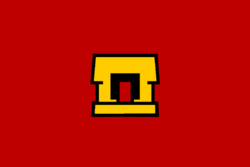Calpullism

Calpullism, (in Nahuatl : Nocalli tlahtōlli) is a political philosophy and anarchist school of thought which advocates for a stateless socialist society in which capitalism, wage labour, and private property, have been abolished in favour of personal property, communal ownership, and an horizontal network of Free Associations based around traditional cultural units. It was first developed by Maxtatlon during the late 19th century, and has since then become the official ideology of the Coalition of Coconeh Calpotlin.
Maxtatlon aimed to create a system capable to “ensure the smooth and efficient liberation of all individuals from both Occidental and Tepanec oppression”. While he was condemned by the Tlatholoyan alongside other “Reformers”, he managed to flee the capital in time and avoid prison. During the turbulent times preceding the Clouds and Flowers Revolution, he organized a few “Free Calpulleh” based around his theory, and gained important followers among farmers and bandits of the Teotlan region. It’s these Free Calpulleh that would form the core of the future Coalition during the War of Thousand Colors.
Today, Calpullism is still the official school of thought of the Coalition of Coconeh Calpotlin which officialy forbid the creation of political parties so that elected Representatives can be “dedicated, body and soul, to the cause of their Community, independent from any clique.” However, many variants and understanding of Calpullism exist, in the absence of a central authority on the matter. all have with different ideas on political decentralization, free trade, personal property, and political freedom. They all, however, share common core tenets layed down by Maxtatlon, and a great attachment to the “Community”. Conflicts between these Calpullists schools are the basis of modern CCC politics.
In other countries, Calpullism remain a minor movement, but has inspired other schools of thought, such as the Keiyan Kyosan-to party which understand the teachings of Misaki Kamikawa through the lense of Maxtatlon's ideology.
History
Economic Theory
Maxtatlon's economic thoughts were based on both Anarcho-communism and Mutualism. He disagreed with the former individualist outlook, considering that "the social fabric of a society can't be mend by ignoring it". With the latter, he came to become an ardent critic of the Labor theory of value. What he kept from both was the abolition of money, wage labours, free association, and the replacement of free banking by mutual banking.
As a result, Calpullism economic theory is often characterized as Free-market anarchism, despite the lack of private property. Maxtatlon and other theoricians after him remained categoric : the means of production should be collectively owned by all the community that depend on it : the lands should be collectively owned by all the farmers of a village who depend on it, and the factories by all of their workers. They then freely distribute the task and the work among them according to their capacities, and either touch their share of the collective enterprise's profit, as Maxtatlon imagined it, or the profits are kept by a collective saving account to be then redistributed to the workers according to their needs as some of his successors imagined.
The Calpulli-Commune
Central to Calpullism is the idea of the Calpulli which has been interchangeably translated as "District", "Ward", or "Commune". In the traditional Nahuatl society, a Calpulli was the designation of an organizational unit below the level of the city whose inhabitants were collectively responsible for different organizational and religious tasks. They controlled land which was available for calpulli members to cultivate and also operated the schools for young commoners. Rural calpulleh were based on lineage, which mean they represented a large extended family descended from a common ancestor, while the urban calpulleh were based more on political and occupational similarities. Maxtatlon recognized the Calpulli as the "most natural introduction possible" of the Coconeh to Communism.
With Maxtatlon, the Calpulli became a free association fusing together aspects of both anarcho-communism and anarcho-syndicalism, being a commune based on both geography and occupational similarities. By transforming the Calpulleh into Free Communes, Maxtatlon aimed to ensure a "seemingless transition" from an autoritarian to a anarchist society and limiting Reactionary behaviors that he considered "naturally occured with every change, be they positive or negative". During the chaotic Flowers and Clouds Revolution and Thousand Colors War, this shift of the political unit away from the State and to the Commune greatly helped the Calpullists to organize themselves and win over the abandoned countryside and the villages that had been left leaderless and without any structure to support them.